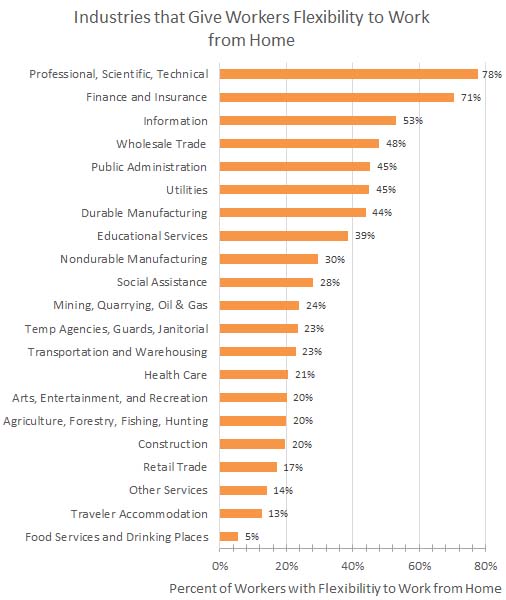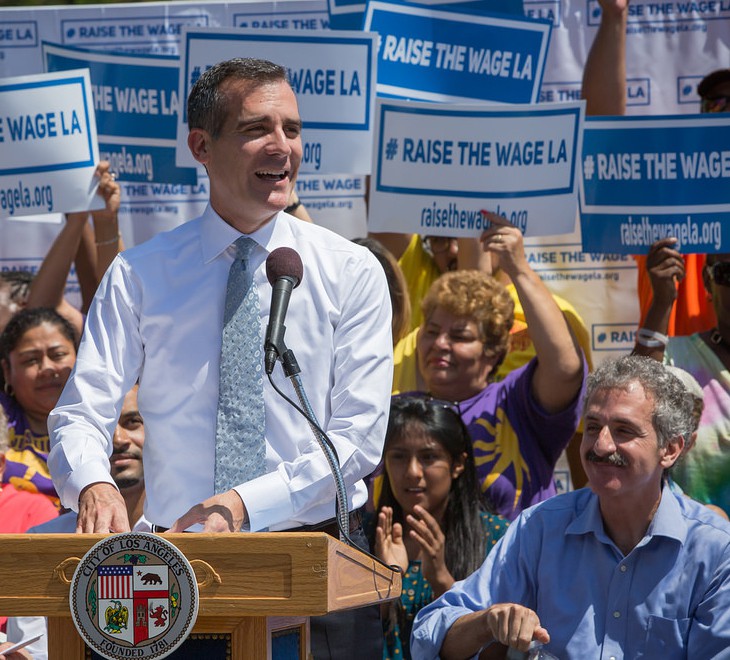 In just one month, the coronavirus disease (COVID-19) has spread from infecting a few, distant countries to become a global pandemic, bringing large parts of California’s economy to a standstill. Public health directives for consumers to stay at home and nonessential businesses to close for an indeterminate amount of time are causing a profoundly disruptive economic shock. We are seeing the economic fabric of workers earning wages from employers and employers receiving revenue from customers disintegrate as workers lose jobs and are unable to pay for basic needs such as housing, and employers lose customers and are unable to pay basic operating costs for preserving their businesses.
In just one month, the coronavirus disease (COVID-19) has spread from infecting a few, distant countries to become a global pandemic, bringing large parts of California’s economy to a standstill. Public health directives for consumers to stay at home and nonessential businesses to close for an indeterminate amount of time are causing a profoundly disruptive economic shock. We are seeing the economic fabric of workers earning wages from employers and employers receiving revenue from customers disintegrate as workers lose jobs and are unable to pay for basic needs such as housing, and employers lose customers and are unable to pay basic operating costs for preserving their businesses.
Meeting the basic needs of unemployed workers throughout this economic downturn is essential for preserving our social fabric and civic institutions. California needs to take direct action to address the economic emergency caused by COVID-19 that is causing widespread business closures and extremely high unemployment. Forty-three percent of California workers have a high risk of unemployment.
Among California counties the share of workers with a high risk of unemployment ranges from 33 percent in San Francisco up to 49 percent in Riverside, Mendocino, Tehama, and Stanislaus counties. Among California communities the share of at-risk workers ranges from 19 percent in Cupertino, Saratoga and Los Gatos in the Bay Area up to 70 percent in the neighborhood immediately south of downtown Los Angeles.
 This report estimates the demography, occupations, industries, and communities of California workers who have a high risk of unemployment so that they and their employers can be located and provided with timely and effective assistance for preventing economic disaster. It uses data about workers, their occupations and the risk of unemployment from the Census Bureau, the Federal Reserve Bank of St. Louis and the U.S. Department of Labor.
This report estimates the demography, occupations, industries, and communities of California workers who have a high risk of unemployment so that they and their employers can be located and provided with timely and effective assistance for preventing economic disaster. It uses data about workers, their occupations and the risk of unemployment from the Census Bureau, the Federal Reserve Bank of St. Louis and the U.S. Department of Labor.
The onset of unemployment has been sudden and widespread, and in the confusion of this economic emergency many suddenly destitute workers may not receive timely help or any help at all unless methodical, evidence-based tools are used to identify them. The information in this report can support systematic efforts to locate unemployed workers and meet their urgent needs.
The burden of unemployment is unequally distributed among workers. It rests most heavily on young adults, Latinos, and workers in restaurant, hotel, personal care, and janitorial jobs. Young adults graduating from school and attempting to enter the job market face extremely difficult challenges.
A consequence of social distancing and business closures to protect public health during the pandemic is to transform the health risks of older individuals, who are most vulnerable to COVID-19, into economic risks for low wage workers, who often are younger individuals and service workers who perform tangible rather than conceptual tasks, and who have the highest risk of unemployment. The assumption underlying this transfer of risk is that we all have an obligation to protect each other’s lives. The reciprocal obligation is to protect each other’s economic well-being, specifically, employment and wages for workers whose jobs have been sacrificed to protect the lives of others.
 Many workers who still have jobs are risking their health. Health care workers have uniquely high risks of being infected with COVID-19 because they have very frequent direct physical contact with infected individuals. The risk of being infected by the coronavirus as a result of working in close proximity to other people is greatest among physicians, nurses, and medical technicians. There also are elevated risks of infection for low income workers, African Americans, Latinos, young adults, health care support workers such as home health aides, personal care workers such as child care workers, and protective service workers such as police officers and firefighters.
Many workers who still have jobs are risking their health. Health care workers have uniquely high risks of being infected with COVID-19 because they have very frequent direct physical contact with infected individuals. The risk of being infected by the coronavirus as a result of working in close proximity to other people is greatest among physicians, nurses, and medical technicians. There also are elevated risks of infection for low income workers, African Americans, Latinos, young adults, health care support workers such as home health aides, personal care workers such as child care workers, and protective service workers such as police officers and firefighters.
Many households already have unpaid rent, bills and loan obligations. Half of California’s workers earn $40,000 or less a year. These workers are likely to have little or no financial reserves and many are encumbered with debt. Workers in this group who are unemployed, or become unemployed, need immediate wage replacement.Similar financial safety nets need to be extended to small and medium size businesses in order to preserve California’s employment base. California has over 940,000 employment establishments, and over 800,000 of these establishments have less than 20 employees. This is an extraordinarily large and diverse employment community to locate, engage, and provide with timely, effective financial support.
 The information shown in this report is available in much greater detail, breaking out workers in every demographic group, with every type of employer, in 265 communities, 269 industries, and 525 occupations.As workers lose their jobs, businesses close and family incomes vanish, California government agencies, foundations and community-based organizations need to act rapidly to identify unemployed workers and provide all available regulatory, material and economic assistance. This support is particularly important in communities where a large share of workers have a high risk of unemployment and includes:
The information shown in this report is available in much greater detail, breaking out workers in every demographic group, with every type of employer, in 265 communities, 269 industries, and 525 occupations.As workers lose their jobs, businesses close and family incomes vanish, California government agencies, foundations and community-based organizations need to act rapidly to identify unemployed workers and provide all available regulatory, material and economic assistance. This support is particularly important in communities where a large share of workers have a high risk of unemployment and includes:
- Food banks with adequate food inventories and staffing to meet community needs.
- Regulatory, legal aid and community outreach staff to ensure that community residents receive the full benefit of all types mandated economic relief including moratoriums on evictions, foreclosures, utility shut-offs, and consumer debt collection.
- Access to all forms of economic support including Unemployment Insurance and CARES Act payments, Pandemic Unemployment Assistance, public assistance benefits, disability insurance, and Paid Family Leave.
- Outreach to employers to encourage and help structure work sharing programs that retain as many workers as possible on employers’ payrolls and preserve their eligibility for employee benefits including health insurance.
- Health care and health insurance.
- Emergency housing.
- Public employment programs and job training and re-employment programs.
Press Coverage
Mapping Los Angeles’s Unequal Covid-19 Surge
By Jill Cowan, New York Times (February 1, 2021)
In L.A., the Virus Is Pummeling Those Who Can Least Afford to Fall Ill
By Jill Cowan and Matthew Bloch, New York Times (January 29, 2021)
En Los Ángeles, el virus impacta a aquellos que menos pueden enfermarse
By Newsroom, Infobae (February 3, 2021)
Homelessness Could Rise 45 Percent in One Year Due to Unemployment Crisis
By Igor Derysh, Salon (May 23, 2020)
Some parts of LA are traffic free, others are still humming
By Nisha Venkat, Crosstown (May 22, 2020)
Mass unemployment over coronavirus could lead to a 45% jump in homelessness, study finds
By Benjamin Oreskes, Los Angeles Times (May 14, 2020)
Who Is Likely to Become Unemployed?
By Jill Cowan, New York Times (April 16, 2020)
Over 40% of California’s Workers Face Unemployment Risk, New Study Finds
By Michelle Wiley, KQED (April 17, 2020)
US job losses surge, April unemployment claims highest ever recorded
By Tom Vacar, KTVU Channel 2 News San Francisco/Oakland/San Jose (April 16, 2020)
The rent is due, call 911 / LAPD reports of landlord-tenant disputes jump 300% amid stay-at-home orders
By Ethan Ward, Crosstown / The Eastsider (April 20, 2020)
These Bay Area counties have the lowest share of workers in jobs at risk for unemployment
By Leonardo Castañeda, Bay Area News Group (April 24, 2020)
Marin layoffs mount as pandemic damages economy
By Richard Halstead, Marin Independent Journal (April 25, 2020)
Will The Economy Recover Swiftly? Some Economists Predict It Will Be A Slow Road
Kaiser Health News (April 20. 2020)
One month after coronavirus shutdown, Sonoma County looks forward to future
Julie Johnson, The Press Democrat and Argus Courier (April 20, 2020)
Economic Pain and Frustration Grow in Orange County Under Stay Home Orders
By Spencer Custodil, Voice of OC (April 17, 2020)
Economy becomes mixed-bag in Inland Empire amid coronavirus pandemic
By Rob McMillan, Eyewitness News ABC 7 (Tuesday, April 14, 2020)
Economic impact hits Redlands area hard
By Alejandro Cano, Redlands Community News (April 14, 2020)
Coronavirus: 42% of Orange County jobs in industries at high-risk of layoffs
By Jonathan Lansner, Orange County Register (April 13, 2020)
Coronavirus layoffs: 49% of jobs in San Bernardino County industries at risk
The San Bernardino Sun (April 13, 2020)
Workers at high risk of unemployment in the COVID-19 pandemic
Reporters Desk, Random Lengths News (April 13, 2020)
Coronavirus Puts Nearly Half Of LA Workers At Risk Of Losing Their Jobs
By David Wagner, LAist (April 10, 2020)
Without Rent Forgiveness, Experts Say Homelessness Will Just Get Worse
By Matt Tinoco, LAist (April 7, 2020)
Plotting A Path To Regional Economic Recovery
By The Jefferson Radio Team, Jefferson Public Radio (April 10, 2020)
California faces two years of high unemployment from coronavirus
By Margot Roosevelt, Los Angeles Times (April 10, 2020)













